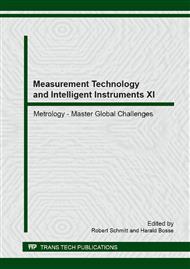p.3
p.11
p.17
p.26
p.37
p.43
p.51
p.58
New Avogadro Spheres for the Redefinition of the Kilogram
Abstract:
The General Conference on Weights and Measures (CGPM) discusses the improvements of a possible revision of the International System of Units (SI). For the new definition of the kilogram apart from an artifact of Platinum-Iridium a suitable fundamental constant seems to be found, to which the kg could be related. Although the Planck constant, h, is being considered for the new definition, its value can currently be determined with less uncertainty from the value of the Avogadro constant, NA. As well the determination of the Avogadro constant is suitable as a primary method for the subsequent realization of the kilogram. The international Avogadro group has reached so far a relative measurement uncertainty of 3×10-8, mainly limited by the interferometric measurement of the volume of the 28Si-spheres, used to count the atoms. The dominant influence on the measurement uncertainty is a contribution which subsumes wavefront aberrations due to surface deviations and irregularities of the spheres polished from our partner at CSIRO, Australia. A new multi-step machining process, developed and realized at PTB, reduces considerably the surface contamination and creates spheres with surface properties which exceed the standards in matters of form deviation and surface roughness. The manufacturing process incorporates highly reproducible multi-step grinding and polishing steps. The surfaces are almost free of scratches and show average roughness values below 0.3 nm. The form shows some regular, long wavelength errors below 30 nm in amplitude, collocated conform to crystal orientation.
Info:
Periodical:
Pages:
17-25
Citation:
Online since:
May 2014
Authors:
Keywords:
Price:
Сopyright:
© 2014 Trans Tech Publications Ltd. All Rights Reserved
Share:
Citation:


